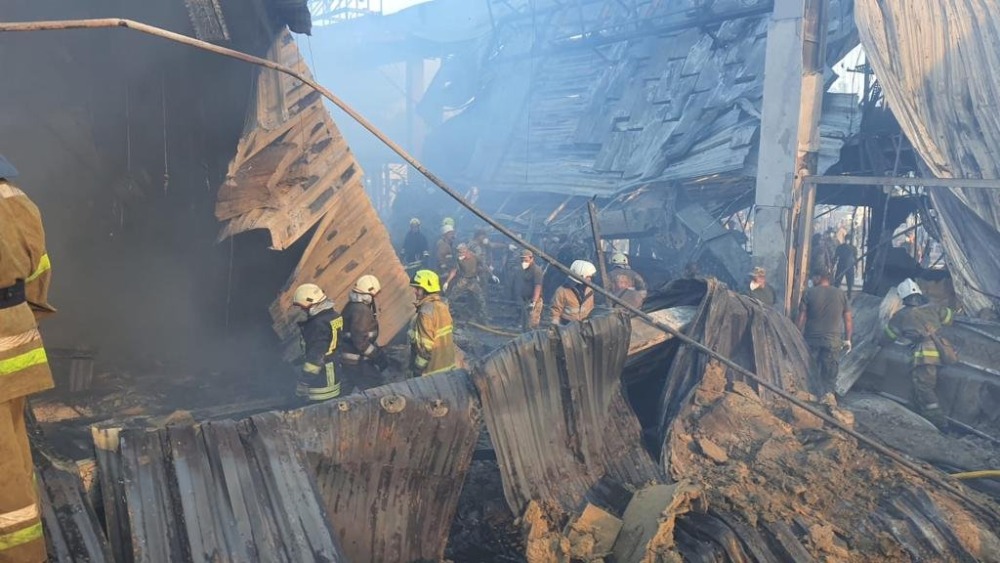How Russian Public Opinion Responded to the Kremenchuk Missile Strike

On June 27, a Russian missile attack hit a shopping mall in the central Ukrainian city of Kremenchuk, and news of the strike seemed to cause a decline in public support for the special military operation more broadly. The mall caught fire and quickly burned to the ground. Ukrainian president Volodymyr Zelensky said that there were over 1,000 people inside the mall when the strike occurred. At least 20 people were killed and dozens were wounded in the attack.
Russian misinformation about the Kremenchuk attack
By the next day, June 28, Russian authorities had developed a new narrative about the missile strike. A spokesman for the Russian Ministry of Defense stated that the fire occurred “due to the detonation of ammunition for Western weapons that was being held at a nearby factory.” He added that the mall was “not functioning” when it caught fire.
Many fact-checkers, including the BBC, the Guardian, and Bellingcat, have dismissed these and other Russian claims as false. The BBC noted that these two Russian narratives–that the attack was a Ukrainian provocation and that it was a strike against a nearby Western ammunition dump–contradict each other: “It's the latest example of a common tactic used by supporters of the Russian government - throwing multiple, conflicting, evidence-free narratives out in the immediate aftermath of an attack.”
Tracking Kremenchuk in public opinion data
Russia Watcher’s fine-grained daily public opinion data allows us to track how sudden events like the Kremenchuk attack correspond to changes in ordinary Russians’ attitudes toward the war in Ukraine. Between June 27, the day of the attack, and June 28, we observed a small uptick in public support for Russia’s decision to conduct a “special military operation”: from 73.3% to 74.6%. However, between June 28, when information about Kremenchuk had spread more widely and Russian media began to broadcast conflicting explanations by Russian officials, and June 29, there was a downward spike in public support: from 74.6% to 71.1%--the lowest level we have observed since launching Russia Watcher on May 19. Following the shift in the propaganda narrative on June 30, support for the operation rebounded to previous levels. While we cannot definitively link this shift in public opinion to Kremenchuk, the data are telling, particularly given how salient this issue became in Western and Russian media. A more difficult question to answer is why public support for the “special military operation” decreased after Kremenchuk. Does this reflect a flaw in Russian propaganda?

Although overall support for the “special military operation” decreased in the days after Kremenchuk, we did not observe a change in the percentage of Russians who said that they would cancel the special military operation if they could. This figure has remained remarkably stable since we began asking it on June 19. On June 28, support for canceling the operation stood at 40.1%, while on June 29 it reached 40.2%–a negligible increase.
Nor did we see any meaningful change in Russian respondents’ concern about Ukrainian civilian casualties in the aftermath of the Kremenchuk strike. On June 27, the date of the strike, and June 28, 87.4% of Russians claimed to be at least somewhat worried about Ukrainian civilian casualties. On June 29, the figure was 87.2%. Although this statistic shows that a very large proportion of Russians are concerned about the fate of ordinary Ukrainians, they tend to blame Ukrainian civilian casualties on the Ukrainian army–not the Russian army. Only 12.7% of respondents over the course of our survey reported blaming Russia for Ukrainian civilian deaths, with 63.8% blaming Ukraine and 23.4% stating that Russia and Ukraine are both to blame.
Russian concern for civilian casualties remained high but unchanged

These figures reflect Russian citizens’ warped perception of reality; while Western and independent Russian language media outlets regularly report on Russia’s attacks against civilian objects, Russian state-run media either: fails to cover such events, denies that they happened, or shifts the blame onto Ukraine. In the Kremenchuk case, the Russian government took a contradictory stance, both first the strike a “provocation” and then claiming that in fact no Ukrainians had been inside the mall when it caught fire. This strategy may explain why worry about Ukrainian civilian casualties did not increase; most Russians either did not see or did not believe the reports about Ukrainians killed in the attack.
The figures reported here suggest that Russian public attitudes toward the war in Ukraine do respond to current events, but the state propaganda machine prevents people from accessing accurate information about what really happened. Using Russia Watcher, we are currently using additional data and experimental methods to conduct a deeper analysis of the propaganda surrounding the Kremenchuk missile strike, and how it affects public opinion. Keep an eye out for future results!
(Photo Credit: State Emergency Service of Ukraine)




